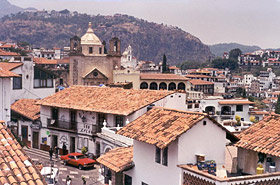 |
 |
 |
 Travel & Outdoors | May 2005 Travel & Outdoors | May 2005  
Traversing The Winding Roads Of Taxco
 Jim Budd - The Herald Mexico Jim Budd - The Herald Mexico


| | Where once it was U.S. citizens who swarmed into Taxco and seemed never to want to leave, now the tourists are from all over. |
Charming and picturesque, Taxco appears on the verge of a renaissance. Not too many years ago the little silver mining city was a major travel destination in Mexico, attracting more tourists than anyplace except Acapulco or the capital.

Those days may be gone forever, but you need only glance around at all the faces in the Zocalo to see that Taxco no longer is forgotten. Never think of finding a room at a good hotel on a weekend without calling ahead for a reservation. And if you think of the Periferico as a parking lot, wait until you try to navigate the crammed, narrow streets of Taxco.

Where once it was U.S. citizens who swarmed into Taxco and seemed never to want to leave, now the tourists are from all over. Weekend visitors from the capital flock into the luxurious Hotel Monte Taxco with its swimming pool, hilltop golf course and Swiss teleferico, or cable car, leading down to the jewelry shops. Foreigners often prefer the smaller, less elegant inns in town.

Silver and tourism always have been the lifeblood of Taxco. Silver came first and made José de la Borda the richest man in the Western Hemisphere. Taxco silver taken east by galleons paid for all those treasures from the Orient shipped back to Acapulco. Only during the troubled 19th century did the mining business falter.

Tasqueños credit William Spratling with getting things moving again. Spratling arrived in the 1930s, invited to Mexico by U.S. Ambassador Dwight Morrow. Spratling stayed. A university professor, he saw a golden opportunity in Taxco silver and enrolled local craftsmen into fashioning jewelry. He sold their work abroad, but it seems he shared the wealth and everybody profited.

Then there was Jimmy Dubin, who, sadly, seems almost forgotten now. Dubin pioneered in taking tourists to Taxco. He, too, started out in the 1930s, picking up passengers from the banana boats docked in Acapulco and rushing them out of the heat into the cool mountains where Taxco is nestled. In the 1950s and 1960s, Dubin thrived by busing tourists in the opposite direction, from the capital to the beach with an overnight stop in Taxco, where Dubin owned three hotels. The charm of what was then a hillside village of cobbled streets and stone houses topped with tiled roofs, delighted visitors.

For many of these tourists, one night was not enough. They wanted to come back. Sully Sullivan gave them a place to stay, converting the ancient Hacienda del Chorrillo into a small, exclusive hotel. Guests needed a recommendation to be admitted. Sully always insisted that he was not being a snob, but simply trying to avoid difficulties. Meals at the Chorillo were served at one specific hour. Guests sat at one long table and ate or did not eat what they were served. Everyone spoke English. "Many people simply would not be happy here," Sully said. "We recognized that."

It was for these people that Alfredo Checa opened what is now the Monte Taxco, something of an engineering miracle, built on the summit of a rather formidable mountain. Amazingly, the Monte Taxco is nicer now than when it opened in 1974. Checa's success has inspired others to invest in hotels. The old Dubin properties recently were purchased and, the press is told, will be rehabilitated. Santa Prisca, that landmark church that Borda silver bought and paid for more than two centuries ago, is having its face scrubbed. Now if only something could be done about all those cars clogging the streets.

Contact Jim Budd at Fax 5682-6023 or jimmbudd1@aol.com | 
 | |
 |



